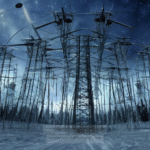What Are the Secrets Behind the Mokele-Mbembe, the African River Dinosaur?
What Are the Secrets Behind the Mokele-Mbembe, the African River Dinosaur?
The Mokele-Mbembe is a cryptid that has captured the imagination of explorers, scientists, and enthusiasts in the field of cryptozoology for decades. Often described as a large, long-necked creature resembling a sauropod dinosaur, this enigmatic being is said to inhabit the Congo River Basin. But what makes the Mokele-Mbembe such an intriguing subject of study? Why do so many people believe in its existence despite the lack of concrete evidence? In this blog post, we’ll delve into the mystery of the Mokele-Mbembe, examining its historical context, the theories surrounding its existence, and the ongoing efforts to uncover the truth about this elusive creature.
Historical Context: The Legend of Mokele-Mbembe
The legend of the Mokele-Mbembe has its roots in the folklore of the Bakuba and other tribes of the Congo region. The name itself translates to “one who stops the flow of rivers,” a description that reflects the creature’s immense size and power. The first documented sightings date back to the late 19th century when Western explorers began to report tales of a large, dinosaur-like creature lurking in the rivers of Central Africa.
In 1909, a famous explorer named Paul Du Chaillu brought attention to the Mokele-Mbembe after hearing stories from local villagers during his expeditions. His accounts sparked interest among cryptozoologists and adventurers, leading to numerous expeditions into the Congo Basin, each attempting to uncover the truth behind the legend.
Core Concepts: What Do We Know About Mokele-Mbembe?
The Mokele-Mbembe is often depicted as a large creature with a long neck, resembling a sauropod dinosaur like the Brachiosaurus or Apatosaurus. Descriptions vary, but common features include:
- A long, flexible neck
- A large, bulky body
- Four sturdy legs
- Grayish or greenish skin
- A long tail
Most sightings describe it as being between 20 and 40 feet long, traversing the shallow waters of rivers with ease. It is often said to be herbivorous, feeding on aquatic plants and vegetation along the riverbanks.
Practical Evidence: Sightings and Expeditions
While the Mokele-Mbembe remains unproven, numerous expeditions have sought to find evidence of its existence. Some notable expeditions include:
- 1980s Expedition: A group led by Dr. Roy P. Mackal conducted field research in the Congo and interviewed locals about their experiences with the creature.
- 2001 Expedition: A team from the Animal Planet show “Destination Truth” ventured into the Congo Basin, capturing footage of large creatures in the water, although nothing definitive was documented.
- 2015 Expedition: A group of researchers utilized modern technology, including drones and remote cameras, to search for signs of the Mokele-Mbembe.
Despite these efforts, no definitive proof has been found. However, many believers argue that the dense jungle environment makes it challenging to gather conclusive evidence.
Core Theories: What Could the Mokele-Mbembe Be?
Several theories attempt to explain what the Mokele-Mbembe might be if it exists. Here are some of the leading hypotheses:
- Surviving Dinosaur: Some cryptozoologists believe that the Mokele-Mbembe is a surviving species of dinosaur that has adapted to its environment over millions of years.
- Misidentified Animals: Others suggest that sightings may actually be large animals such as hippos or elephants, which can be misinterpreted in the context of local legends.
- Collective Folklore: The Mokele-Mbembe may simply be a manifestation of collective mythology, reflecting deep-seated cultural beliefs rather than a physical reality.
Alternative Perspectives: Skepticism and Criticism
Skeptics argue that the lack of physical evidence, coupled with the implausibility of a large dinosaur-like creature surviving undetected in today’s world, makes the belief in Mokele-Mbembe unlikely. Critics often point to:
- Scientific Limitations: The absence of fossil evidence or biological samples to support claims.
- Psychological Factors: The influence of folklore and cultural narratives on perceptions of unexplained phenomena.
- Environmental Challenges: The inhospitable and remote nature of the Congo rainforest complicates search efforts.
Despite the skepticism, the allure of the Mokele-Mbembe continues to captivate the imagination of many, leading to ongoing interest and inquiry.
Common Misconceptions: Debunking Myths
As with many cryptids, the Mokele-Mbembe is surrounded by misconceptions. Here are a few common myths debunked:
- Myth 1: It is a confirmed dinosaur. Reality: There is no scientific evidence to classify it as a dinosaur; it remains a cryptid.
- Myth 2: Many people have seen it. Reality: While many claim to have seen it, most sightings are anecdotal and lack corroborative evidence.
- Myth 3: It is hostile to humans. Reality: Most accounts do not depict the Mokele-Mbembe as aggressive or dangerous.
Best Practices for Investigating Cryptids
If you’re interested in pursuing research on the Mokele-Mbembe or similar cryptids, here are some best practices:
- Documentation: Keep detailed records of sightings, interviews, and evidence.
- Collaboration: Work with local communities to gain insights and build trust.
- Scientific Approach: Employ methods of scientific inquiry, including hypothesis testing and evidence gathering.
- Respect for Nature: Prioritize conservation and respect for local wildlife and habitats in your research.
Future Developments: Ongoing Research and Exploration
The quest for the Mokele-Mbembe continues, with new expeditions planned and scientific advancements facilitating further exploration. Researchers are utilizing modern technology such as:
- Drone Surveillance: For aerial reconnaissance of hard-to-reach areas.
- Remote Cameras: To capture footage in natural habitats without human interference.
- Environmental DNA (eDNA) Analysis: To detect potential biological traces of unknown species in water samples.
As technology evolves, the possibility of uncovering secrets about the Mokele-Mbembe or similar cryptids becomes more feasible, keeping the mystery alive.
Conclusion: The Enduring Mystery of Mokele-Mbembe
The Mokele-Mbembe remains one of the most fascinating cryptids in the world of cryptozoology. While there is no definitive proof of its existence, the stories, theories, and ongoing investigations continue to enthrall both believers and skeptics alike. As we explore the depths of the Congo Basin and the rich tapestry of human imagination, the legend of the Mokele-Mbembe serves as a reminder of the mysteries that still lie beyond our understanding. Whether it is a surviving dinosaur, a misidentified animal, or merely a myth, the pursuit of the Mokele-Mbembe highlights our innate curiosity and desire to explore the unknown. 💡
Other Articles
Recent Posts
- What Happened to Flight MH370? The Conspiracy Theories That Still Haunt Us
- What Secrets Lurk Within the Walls of the Infamous Trans-Allegheny Lunatic Asylum?
- What Evidence Supports the Existence of Bigfoot in the Pacific Northwest?
- What Happened to the Indus Valley Civilization? Unraveling the Mysteries of Ancient Urban Life
- Can Telepathy Be Scientifically Proven Through Laboratory Evidence?







